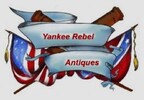 Loading... Please wait...
Loading... Please wait...-
Call us on (973) 810-2976
- My Account
- Gift Certificates
- Items / $0.00
All prices are in All prices are in USD
Categories
- Home
- Sold, Hold, Layaway items
- RARE - Revolutionary War Boat Hook/Pike, recovered at Lake Champlain (SOLD,N)
RARE - Revolutionary War Boat Hook/Pike, recovered at Lake Champlain (SOLD,N)
Out of Stock
Product Description
This is another nice early piece coming out of a 60-year collection of French & Indian War/Revolutionary War collection. Being offered is a Revolutionary War soldier’s “Boat Hook”. It is forged iron, 11 1/2” length with a diamond section fore spike and angled back hook. It was designed to take a 1 ¼” wooden pole. There is an example of this piece in “Collector’s Illustrated Encyclopedia of the American Revolution”, by Neumann and Kravic (see pictures).
This type of weapon would have been used to either board a boat while attacking or to repel enemy boarders, or also to "hook" onto items or limbs during a Naval battle. They were also capable of pulling a rider from his horse and inflicting a fatal wound. It was recovered many years ago at Lake Champlain, NY. This area was called the Battle of Valcour Island.
Valcour Island is on the western side of Lake Champlain between the present-day states of Vermont and New York. On October 11, 1776, the British fleet under the overall command of Guy Carleton traveled south on Lake Champlain from their supply base at St. John. Benedict Arnold was waiting in Valcour Bay, hidden from the British view until they rounded the island.
In the subsequent three-day battle, the British destroyed or captured 11 of the 15 Patriot boats. While a resounding tactical victory, the British were unable to capitalize on their control of Lake Champlain to capture Fort Ticonderoga. After a desultory probe, Carleton led his forces back to Canada for the winter. This battle was the only ‘fleet on fleet” naval battle of the Revolutionary war between British and Patriot ships. The USS Philadelphia was involved in the battle and is now in the Smithsonian in Washington, DC (see pictures).
The hook remains in very nice solid condition, having a mostly smooth surface, typical of an early recovery. This collection began in the late 1950s and was created by private acquisitions, closed museums, and from lake divers. He meticulously displayed and cataloged every piece along with its provenance. His markings were crude at the time, but now they have proved to be very important. Many of the pieces went through electrolysis to remove crusted rust.
This is the first time this rare artifact has been on the open market, and it is truly a great piece of early American History. As with all the pieces in this esteemed collection, a certificate of authenticity will be supplied. The very friendly layaway is available on this item, as well as the other items on the website.



